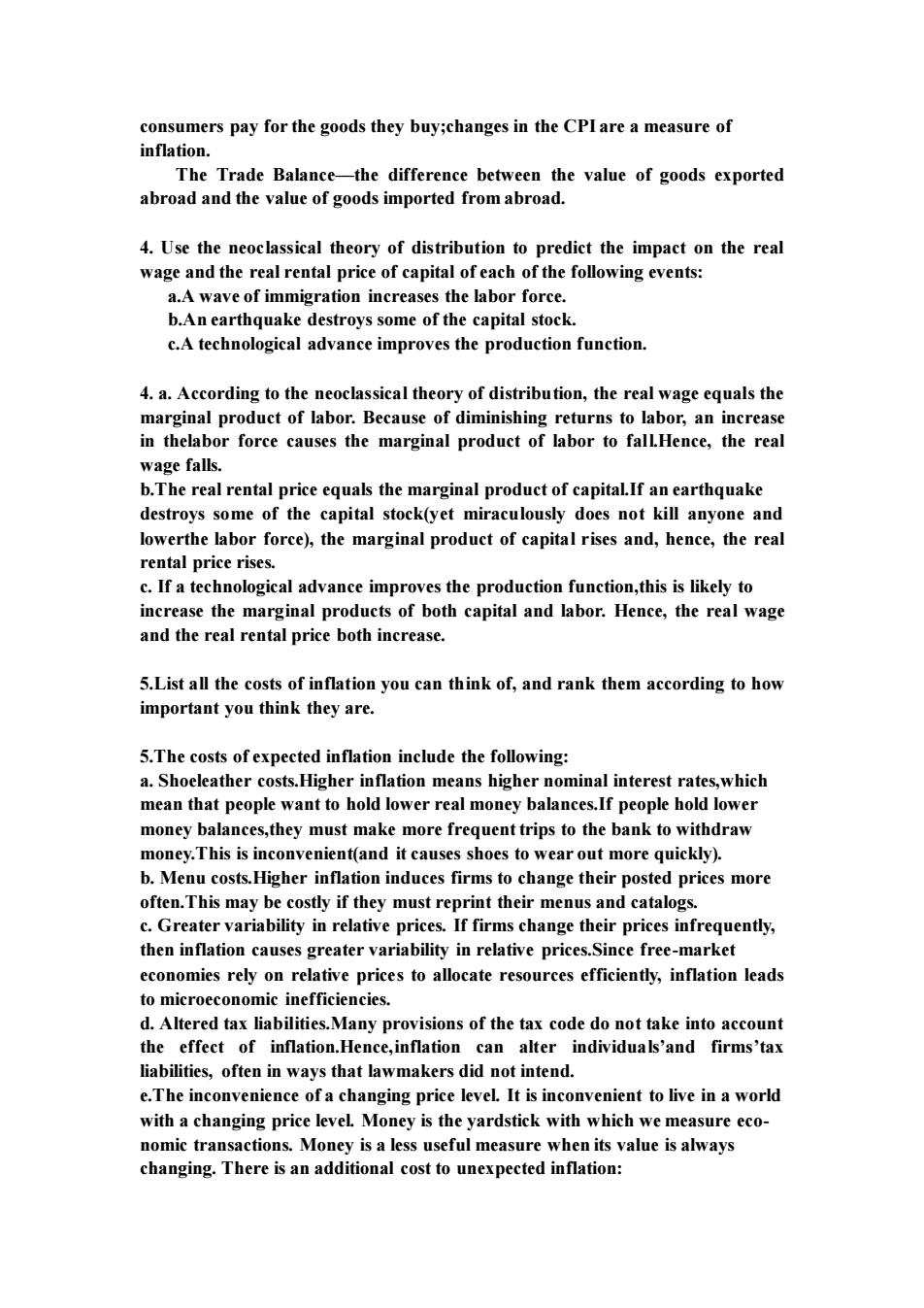正在加载图片...

consumers pay for the goods they buy;changes in the CPI are a measure of The Trade Balance-the difference between the value of goods exported abroad and the value of goods imported from abroad. 4.Use the neoclassical theory of distribution to predict the impact on the real wage and the ental p eof capital of each of the following events Awave of imm igration increases the lab b.An earthquake destroys some of the capital stock. c.A technological advance improves the production function. 4.a.According to the neoclassical theory of distribution,the real wa equals the I product of labor Because of dim returns to la eabor force causes the marginal product of labor to fae r,an increas wage falls. b.The real rental price equals the marginal product of capital.If an earthquake destroys some of the capital stock(yet miraculously does not kill anyone and lowerthe lab r force),the marginal product of capital rises and,hence,the real rental price rises. c.If a technological advance improves the production function,this is likely to increase the marginal products of both capital and labor.Hence,the real wage and the real rental price both increase. 5.List all the costs f inflation you can think of,and rank them according to how important you think they are. 5.The costs of expected inflation include the following: oetsiesr nomin mean that people ant to money bala hold owe money balances,they must make more frequent trips to the bank to withdraw money.This is inconvenient(and it causes shoes to wear out more quickly). b.Menu costs.Higher inflation induces firms to change their posted prices more often.This may be costly if they must reprint their menus and catalogs c.Greater variability in relative ces.If firms change their prices infrequently then inflation causes greater variability in relative prices.Since free-marke economies rely on relative prices to allocate resources efficiently,inflation leads to microeconomic inefficiencies. d.Altered tax liabilities.Many provisions of the tax code do not take into account the effect of inflation.Her e,inflation can alter individuals'and firms'tax bilities, fte in ways that lawmaker sdid not in end. e.The inconvenience of a changing price level.It is inconvenient to live in a world with a changing price level.Money is the yardstick with which we measure eco- nomic transactions.Money is a less useful measure when its value is always changing.There is an additional cost to unexpected inflation: consumers pay for the goods they buy;changes in the CPI are a measure of inflation. The Trade Balance—the difference between the value of goods exported abroad and the value of goods imported from abroad. 4. Use the neoclassical theory of distribution to predict the impact on the real wage and the real rental price of capital of each of the following events: a.A wave of immigration increases the labor force. b.An earthquake destroys some of the capital stock. c.A technological advance improves the production function. 4. a. According to the neoclassical theory of distribution, the real wage equals the marginal product of labor. Because of diminishing returns to labor, an increase in thelabor force causes the marginal product of labor to fall.Hence, the real wage falls. b.The real rental price equals the marginal product of capital.If an earthquake destroys some of the capital stock(yet miraculously does not kill anyone and lowerthe labor force), the marginal product of capital rises and, hence, the real rental price rises. c. If a technological advance improves the production function,this is likely to increase the marginal products of both capital and labor. Hence, the real wage and the real rental price both increase. 5.List all the costs of inflation you can think of, and rank them according to how important you think they are. 5.The costs of expected inflation include the following: a. Shoeleather costs.Higher inflation means higher nominal interest rates,which mean that people want to hold lower real money balances.If people hold lower money balances,they must make more frequent trips to the bank to withdraw money.This is inconvenient(and it causes shoes to wear out more quickly). b. Menu costs.Higher inflation induces firms to change their posted prices more often.This may be costly if they must reprint their menus and catalogs. c. Greater variability in relative prices. If firms change their prices infrequently, then inflation causes greater variability in relative prices.Since free-market economies rely on relative prices to allocate resources efficiently, inflation leads to microeconomic inefficiencies. d. Altered tax liabilities.Many provisions of the tax code do not take into account the effect of inflation.Hence,inflation can alter individuals’and firms’tax liabilities, often in ways that lawmakers did not intend. e.The inconvenience of a changing price level. It is inconvenient to live in a world with a changing price level. Money is the yardstick with which we measure economic transactions. Money is a less useful measure when its value is always changing. There is an additional cost to unexpected inflation: